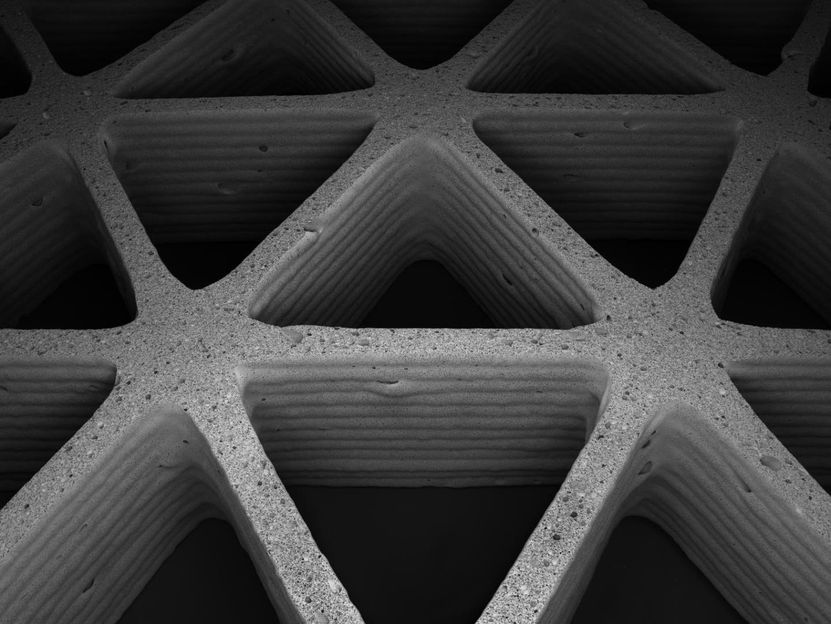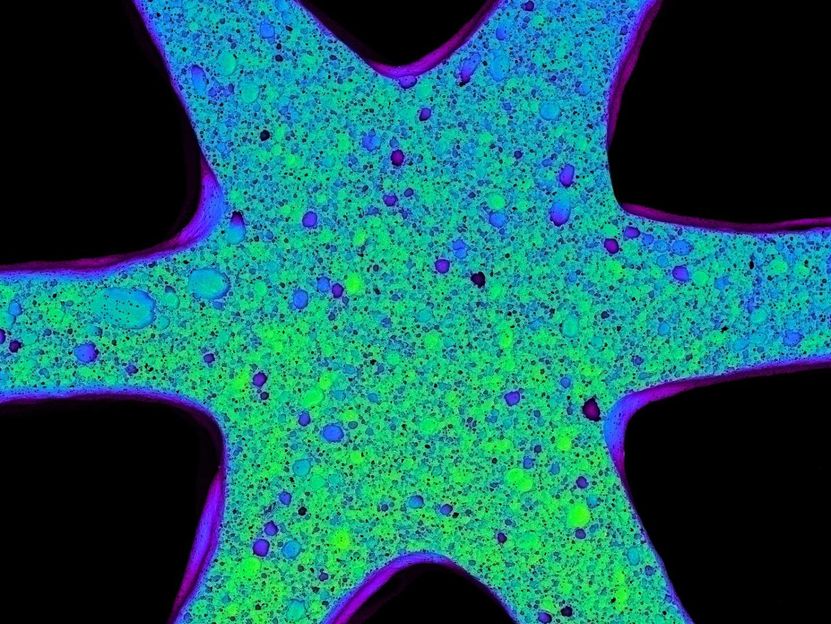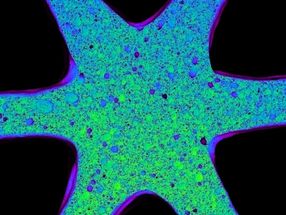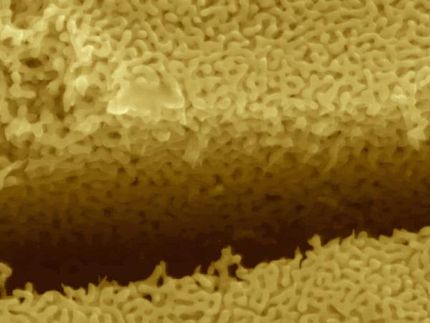Mimicking nature's cellular architectures via 3-D printing
Nature does amazing things with limited design materials. Grass, for example, can support its own weight, resist strong wind loads, and recover after being compressed. The plant's hardiness comes from a combination of its hollow, tubular macrostructure and porous microstructure. These architectural features work together to give grass its robust mechanical properties.

Harvard and MIT researchers 3-D printed lightweight hexagonal and triangular honeycombs (pictured here), with tunable geometry, density, and stiffness using a ceramic foam ink. Their approach could be used to fabricate lightweight structural materials, thermal insulation or tissue scaffolds.
Image courtesy of James Weaver/Wyss Institute

Close up image of one node of the triangular honeycomb. The structure, which consists of air surrounded by ceramic, can be designed with specific porosity.
Image courtesy of James Weaver/Wyss Institute


Inspired by natural cellular structures, researchers at the Harvard John A. Paulson School of Engineering and Applied Sciences (SEAS), the Wyss Institute for Biologically Inspired Engineering at Harvard University, and MIT have developed a new method to 3D print materials with independently tunable macro-and microscale porosity using a ceramic foam ink.
Their approach could be used to fabricate lightweight structural materials, thermal insulation or tissue scaffolds.
The research is published in the Proceedings of the Natural Academy of Sciences.
"By expanding the compositional space of printable materials, we can produce lightweight structures with exceptional stiffness," said Jennifer Lewis, Hansjorg Wyss Professor of Biologically Inspired Engineering at SEAS and senior author of the paper. Lewis is also a Core Faculty Member of the Wyss.
The ceramic foam ink used by the Lewis Lab contains alumina particles, water, and air.
"Foam inks are interesting because you can digitally pattern cellular microstructures within larger cellular macrostructures," said Joseph Muth, a graduate student in the Lewis Lab and first author of the paper. "After the ink solidifies, the resulting structure consists of air surrounded by ceramic material on multiple length scales. As you incorporate porosity into the structure, you impart properties that it otherwise would not have."
By controlling the foam's microstructure, the researchers tuned the ink's properties and how it deformed on the microscale. Once optimized, the team printed lightweight hexagonal and triangular honeycombs, with tunable geometry, density, and stiffness.
"This process combines the best of both worlds," said Lorna Gibson, the Matoula S. Salapatas Professor of Materials Science and Engineering at the Massachusetts Institute of Technology, who coauthored the paper. "You get the microstructural control with foam processing and global architectural control with printing. Because we're printing something that already contains a specific microstructure, we don't have to pattern each individual piece. That allows us to make structures with specific hierarchy in a more controllable way than we could do before."
"We can now make multifunctional materials, in which many different material properties, including mechanical, thermal, and transport characteristics, can be optimized within a structure that is printed in a single step," said Muth.
While the team focused on a single ceramic material for this research, printable foam inks can be made from many materials, including other ceramics, metals, and polymers.
"This work represents an important step toward the scalable fabrication of architected porous materials," said Lewis.
Topics
Organizations
Other news from the department science
These products might interest you

Eclipse by Wyatt Technology
FFF-MALS system for separation and characterization of macromolecules and nanoparticles
The latest and most innovative FFF system designed for highest usability, robustness and data quality

HYPERION II by Bruker
FT-IR and IR laser imaging (QCL) microscope for research and development
Analyze macroscopic samples with microscopic resolution (5 µm) in seconds

Get the chemical industry in your inbox
By submitting this form you agree that LUMITOS AG will send you the newsletter(s) selected above by email. Your data will not be passed on to third parties. Your data will be stored and processed in accordance with our data protection regulations. LUMITOS may contact you by email for the purpose of advertising or market and opinion surveys. You can revoke your consent at any time without giving reasons to LUMITOS AG, Ernst-Augustin-Str. 2, 12489 Berlin, Germany or by e-mail at revoke@lumitos.com with effect for the future. In addition, each email contains a link to unsubscribe from the corresponding newsletter.
Most read news
More news from our other portals
Last viewed contents
Alpha_1-antitrypsin
Polypropylene

Bio-based alternatives to single-use plastics - Suzano Ventures invests up to US$5 million into Bioform Technologies to further develop bio-based plastic alternatives
Tellurobismuthite
The_fMRI_Data_Centre
Laser-induced_breakdown_spectroscopy
Pine_Bluff_Chemical_Activity





























































